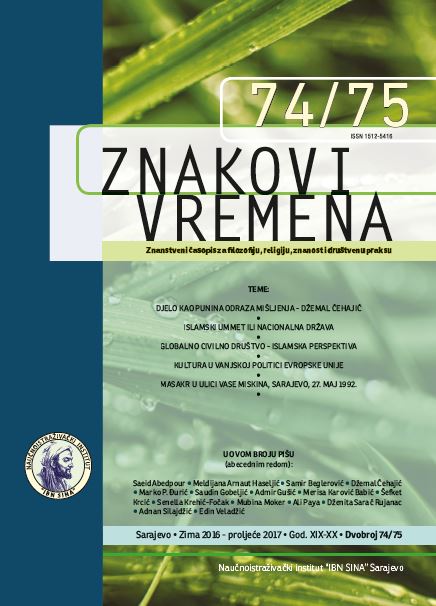Veza između sufizma i komunikologije: Odlike i posebnosti
komuniciranja u sufizmu
The Relationship between Sufism and Communicology: The Characteristics and Specificities of Communicating in Sufism
Author(s): Senella Krehić-FočakSubject(s): Social Sciences, Communication studies, Islam studies, Theory of Communication
Published by: Naučnoistraživački institut »Ibn Sina«
Keywords: Tasawwuf / Sufism; Teacher / Shaykh; spiritual path; Tariqah; heart (Qalb); Nafs (ego); communication; intrapersonal; interpersonal; group and mass communication;
Summary/Abstract: The article discusses the relationship between Sufism and Communicology. First of all, historical facts are introduced that refer to the understanding of the Sufi path and the existence of dervish orders. The connection between Sufism and communication is viewed through a concise description of the form of communication: intrapersonal, interpersonal, group and mass. In relation to the usual intrapersonal, interpersonal, group and masscommunication, in the Tasawwuf / Sufism, as a system of specific communication forms, it is possible to talk about non-standard, specific intrapersonal, interpersonal, group and mass communication. Intrapersonal communication, characterized by isolation or khalwa of a dervish, a future Sufi, and as such is a breakthrough that is only given to a few. Interpersonal one, given the role of a Teacher / Sheikh, is specific by its quality and vertical dimension, and by the Sheikh’s dedication to guidance, leadership on the Sufi path. Group communication takes place at all levels, vertically, horizontally; although less frequently encountered in practice, it is often practiced in Sufism. Mass communication, which goes from the middle to the periphery, even if presented to mass media,does not essentially represent mass communication in Sufism. The very multidimensionality of communication in Sufism, seen first and foremost as internal and external, as a well-known phenomenon of batin – the inner dimension and zahir–the visible and external in Islam in general. The paper highlights the importance of an approach of connectivity, of Sufism and communicology, or in broader sense, of science and spirituality, through the prism of the communicological view of overlapping two empirical fields. In order to achieve the best connection between these two fields, Sufism and Communicology, and illuminate the scientific and social role, it has been attempted to stimulate the spiritual potential by lowering the Sufi mode of communication to a more accessible, pragmatic level. By building up the spiritual potentials of a man whoby self-realisation, self-reflection, self-monitoring, and reparation of his own self, develops his inner potentials, this concept ultimately develops a product-social capital of the society, which gives the advantage of better development of individuals and society as a whole, in order to embody and emanate knowledge.
Journal: Znakovi vremena - Časopis za filozofiju, religiju, znanost i društvenu praksu
- Issue Year: XX/2017
- Issue No: 74-75
- Page Range: 157-178
- Page Count: 22
- Language: Bosnian

